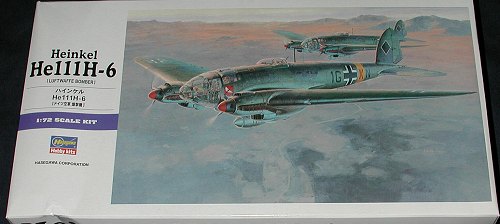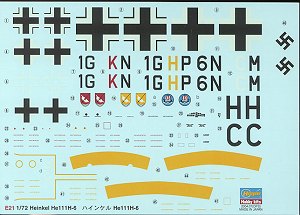
|
KIT: |
Hasegawa 1/72 He-111H-6 |
|
KIT # |
00551 (E 21) |
|
PRICE: |
¥3200 (about $30.00) from Hobby Link Japan |
|
DECALS: |
Three options |
|
REVIEWER: |
Scott Van Aken |
|
NOTES: |

|
HISTORY |
Despite this, many different variants were developed and the He-111 was in production for most of the war, until all bomber production stopped during late 1944 so that more fighters could be built to try to combat the Allied air onslaught. These planes were used as mine-sweepers, cargo aircraft, transports for high-ranking personnel, unit hacks and a number of other various and sundry duties. A few were exported and Spain developed a production line for them, though they had to switch to Merlin engines after their supply of Daimler-Benz engines ran out in the late 1940s.
|
THE KIT |
 One
of the first questions one needs to ask is, "Do we really need a new
He-111 kit?" The answer is a resounding YES. Prior to this, the only
He-111 kits in this scale were by Matchbox, Frog, Airfix, and Italeri. All of them
a bit long in the tooth and of older engineering. Judging by the way the
sprues are laid out, we can expect to see a number of different variants
produced! This particular kit concentrates on the He-111H-6 variant, one
of the most produced versions. Telling one He-111 version from another is
difficult even for the initiated. The biggest telling parts of the
airframe are the engines, especially the exhaust and props used, the
lower gondola and where the fuselage guns are located. Hasegawa will be
producing other dash numbers besides this basic boxing.
One
of the first questions one needs to ask is, "Do we really need a new
He-111 kit?" The answer is a resounding YES. Prior to this, the only
He-111 kits in this scale were by Matchbox, Frog, Airfix, and Italeri. All of them
a bit long in the tooth and of older engineering. Judging by the way the
sprues are laid out, we can expect to see a number of different variants
produced! This particular kit concentrates on the He-111H-6 variant, one
of the most produced versions. Telling one He-111 version from another is
difficult even for the initiated. The biggest telling parts of the
airframe are the engines, especially the exhaust and props used, the
lower gondola and where the fuselage guns are located. Hasegawa will be
producing other dash numbers besides this basic boxing.
As usual, all the sprues save the clear bits are in one bag. This resulted in some damage to parts as they rubbed together during shipment. There are a LOT of sprues in this one and if you have built any of the Hasegawa twins, then you have a good idea of what you are in for. First thing that grabbed me is that this one actually has the interior bomb rack and you can pose the bomb bay doors open. A first as far as I know with regard to the bay doors in 111 kits. Thanks to the way the sprues are set up, you actually get two internal bomb racks so you can use the second on your Roden kit! You are also given external racks which were able to hold bigger bombs and pretty well negated the bomb bay. However, if the plane only had one external rack, the other side of the bay would be operable, making for some interesting possibilities. The cockpit is quite complete and provides an instrument decal only for the main instrument panel. On the inside of the rest of the interior is framing as you can see some of this through the various windows.
Depending on the aircraft you are building, you have the options of different exhaust, a choice of external bomb racks or the use of the standard bomb bay. You do have to drill a few holes for various bits as well. The engines use poly caps so you can just push on the props at the end of construction. I noticed a tiny bit of flash on the prop blades and the wing ejector marks almost punched through the wing, leaving visible marks on the outside of the wing. These may disappear under a coat of paint.
The instructions are the usual excellent ones we have come to expect
from Hasegawa. Colors are
given in generic and Gunze shades with RLM numbers provided where needed.
Markings are for three planes flying in Russia during 1942. All are in
RLM 70/71 splinter over RLM 65 with yellow lower wing tips and fuselage
band. Oddly, the painting guide shows the upper/lower demarcation line to
be very low on the left side and running about mid-fuselage on the right.
This just doesn't seem right to me and I'm betting that it is supposed to
be low on both sides. First is the box art plane from 5./KG 27 with red
spinner tips. The next is 6./KG 27 with yellow spinner tips and the other
is from 4./KG 100 with white spinner tips. Each aircraft has a large unit
badge on the nose. Decals are well printed, though judging from the look
of them they may be a bit transparent as the white does not show up
vividly against the blue background. Fortunately, there are aftermarket
sheets for the 111 that should work well. The sheet also provides a
goodly data suite as well as the fuselage bands so you don't have to
paint it if you don't wish.
Hasegawa. Colors are
given in generic and Gunze shades with RLM numbers provided where needed.
Markings are for three planes flying in Russia during 1942. All are in
RLM 70/71 splinter over RLM 65 with yellow lower wing tips and fuselage
band. Oddly, the painting guide shows the upper/lower demarcation line to
be very low on the left side and running about mid-fuselage on the right.
This just doesn't seem right to me and I'm betting that it is supposed to
be low on both sides. First is the box art plane from 5./KG 27 with red
spinner tips. The next is 6./KG 27 with yellow spinner tips and the other
is from 4./KG 100 with white spinner tips. Each aircraft has a large unit
badge on the nose. Decals are well printed, though judging from the look
of them they may be a bit transparent as the white does not show up
vividly against the blue background. Fortunately, there are aftermarket
sheets for the 111 that should work well. The sheet also provides a
goodly data suite as well as the fuselage bands so you don't have to
paint it if you don't wish.
|
CONCLUSIONS |
Like most of you who enjoy building WWII subjects in 1/72
scale, I'm pretty jazzed about this new kit. It is great that Hasegawa has
started doing medium bombers as many of what are currently on the market
are a bit long in the tooth. I think their B-25 series has done well and is
already gone through several boxings. I anticipate nothing less for this
one and imagine that they have their sights set on things like the B-26,
Ju-88, and A-20, all which have multiple variants; something that Hasegawa
really likes as it stretches their development monies. You can find this kit and many others at
If you would like your product reviewed fairly and quickly by a
site that has over 250,000 visitors a month, please contact
me or see other details in the
Note to
Contributors. . "You have a friend in
Japan."
. "You have a friend in
Japan."